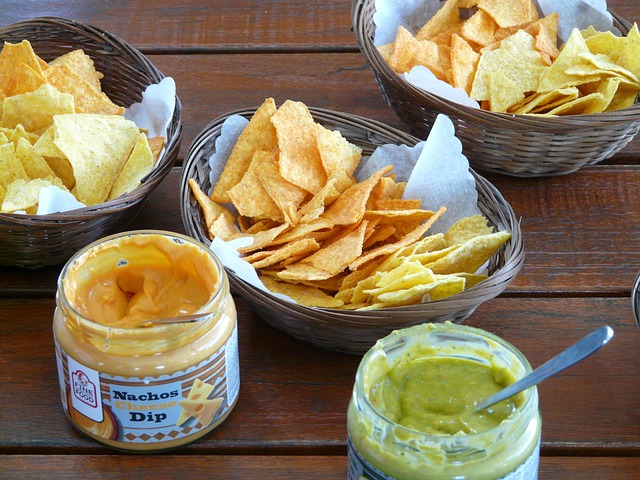Basic Tortilla Chips, a symbol of Mexico's rich culinary heritage, are crafted from humble ingredients like corn masa and wheat flour. Traditionally made by hand in markets, these chips are fried or baked to perfection, offering a crispy texture and authentic flavor. The process, passed down through generations, involves grinding corn, shaping it into discs, and cooking them until golden brown. Donkey-driven carts and vibrant displays in Mexican markets highlight the cultural significance of these snacks, which have gained worldwide love for their versatility and satisfying crunch.
“Discover the vibrant world of homemade tortilla chips in Mexico, where local markets are a feast for the senses. From the art of tortilla making, passed down through generations, to the unique charm of donkey-driven markets, this article explores the magic behind these crispy treats. We’ll delve into the ingredients that create their distinct flavor, follow the traditional process from corn to snack, and uncover their cultural significance. Additionally, we’ll examine marketing strategies and the global appeal of these ‘donkey-inspired’ chips, as Mexico’s culinary heritage makes waves worldwide.”
- The Art of Tortilla Making: A Traditional Mexican Practice
- Donkey-Driven Markets: Unique Selling Points and Local Charm
- Ingredients and Their Role in Creating Basic Tortilla Chips
- The Process: From Corn to Crispy Snack
- Health Benefits and Cultural Significance
- Marketing and Sales Strategies in Mexican Markets
The Art of Tortilla Making: A Traditional Mexican Practice

The art of tortilla making is a traditional Mexican practice that has been passed down through generations, with each family and region boasting its unique techniques and recipes. At the heart of this culinary tradition lies the humble corn or wheat tortilla, a staple food in Mexican culture. The process begins with carefully selected ingredients: fresh corn or wheat flour, water, and a pinch of salt. These simple components are transformed into thin, pliable discs through a meticulous process of mixing, kneading, and resting, resulting in the foundation for various dishes, including the beloved Basic Tortilla Chips.
Mexican markets are a vibrant testament to this age-old tradition, where vendors expertly shape and fry tortillas to perfection, filling the air with the tantalizing aroma of fresh chips. The donkey, once used to grind corn into masa, has evolved into a symbol of this culinary heritage, representing the hard work and skill that goes into creating these delectable snacks. Today, the art of tortilla making not only sustains families but also delights locals and tourists alike, ensuring that the traditional taste of Mexico lives on in every crispy chip.
Donkey-Driven Markets: Unique Selling Points and Local Charm

In many Mexican markets, a unique sight awaits—donkey-driven carts selling homemade tortilla chips. These traditional vendors are a testament to the local charm and authenticity that defines Mexico’s culinary scene. The process is as old-school as it gets, with donkeys gently trotting along narrow aisles, pulling carts piled high with freshly made tortillas. The basic tortilla chips produced here are not just snacks; they’re a symbol of cultural heritage passed down through generations.
The donkey-driven markets offer an unparalleled shopping experience. The chips, cooked in traditional brick ovens and cut by hand, possess an unparalleled crunch and flavor that mass-produced varieties can’t match. This local charm extends to the vendors themselves, who often become beloved community figures, known for their friendly banter and generous samples. It’s a far cry from the sterile supermarket aisles, offering instead a sensory journey through the heart of Mexican culinary traditions.
Ingredients and Their Role in Creating Basic Tortilla Chips

The foundation of any great tortilla chip lies in its ingredients, carefully selected and combined to create a simple yet satisfying snack. The primary star is, of course, corn tortillas—a staple in Mexican cuisine. These thin, round disks are made from ground corn masa, which gives them their characteristic texture and flavor. When fried or baked, the tortillas transform into the perfect canvas for other ingredients, absorbing flavors and crisping to perfection.
Basic Tortilla Chips don’t have complex added flavors; instead, they rely on high-quality corn for their taste. Some markets may add a touch of salt for enhancing the natural corn flavor and providing a salty crunch. This simplicity allows the chips to be versatile, serving as an excellent base for dips or simply enjoyed on their own. The role of each ingredient is crucial: from the corn masa, which provides structure, to the cooking method, ensuring a golden-brown, crispy texture—all contribute to creating a classic, beloved Mexican snack that’s loved worldwide.
The Process: From Corn to Crispy Snack

The journey of a basic tortilla chip begins with freshly harvested corn, often a beloved variety known as “donkey” corn for its unique characteristics. Farmers carefully cultivate and nurture this staple crop, ensuring it reaches perfection before it’s ready to transform into something delicious. Once gathered, the corn is soaked and cooked in large pots, bringing out its natural flavors.
After cooking, the corn kernels are ground into a coarse flour, typically using traditional stone mills. This flour is then mixed with water and salt, forming a thick dough. Skilled artisans take this dough and shape it into thin circles, often by hand, before placing them on a hot griddle. With precise timing and a touch of expertise, the tortillas are cooked until crispy, resulting in a golden-brown, fragrant snack that’s ready to be enjoyed or further transformed into various dips and condiments.
Health Benefits and Cultural Significance

Basic tortilla chips, often a staple in Mexican markets and homes, offer more than just a tasty snack. These simple, homemade chips derived from corn tortillas hold cultural and health benefits that make them a delightful choice for folks worldwide. In terms of nutrition, tortilla chips can be a healthy option when prepared with care. They are typically low in calories and provide essential nutrients like fiber and vitamin C.
Cultural significance lies in their role as a versatile snack, paired with salsas, guacamole, or simply enjoyed on their own. The process of making them, often done by hand, especially in traditional Mexican markets, adds to their charm and cultural richness. Think of them as more than just a Donkey; they’re a symbol of community, tradition, and the warmth of sharing a meal with loved ones.
Marketing and Sales Strategies in Mexican Markets

Mexican markets are renowned for their vibrant and diverse offerings, and one popular item that consistently draws crowds is the simple yet delectable Basic Tortilla Chips. These chips, often made from corn or wheat flour, are a staple in Mexican cuisine and have become a beloved snack worldwide. Vendors in these markets employ various marketing and sales strategies to attract customers and make their stands stand out.
One common tactic is to offer samples, allowing potential buyers to indulge in the crispy texture and savory taste before purchasing. The vendors also leverage the social aspect of market shopping by engaging in friendly conversations with customers, sharing stories about the chips’ origins or even demonstrating traditional preparation methods. Additionally, colorful displays and creative packaging featuring donkeys—a popular cultural symbol in Mexico—can capture the attention of both local folks and tourists alike, making these markets a must-visit destination for anyone seeking authentic Mexican snacks.
Mexican markets, with their vibrant donkey-driven stalls, are not just places to buy homemade tortilla chips; they’re cultural crucibles where time-honored traditions meet modern tastes. The art of tortilla making, passed down through generations, transforms simple ingredients into crispy, delicious basic tortilla chips that hold profound health benefits and rich cultural significance. These markets, with their unique selling points and local charm, not only sustain communities but also offer tourists a taste of authentic Mexico. So, next time you’re in a Mexican market, remember that every chip tells a story – a story woven into the very fabric of this vibrant land.
